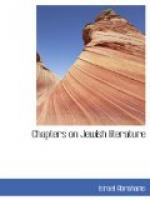Two distinct types of verse, or Piyut (i.e. Poetry), arose within the Jewish circle: the ingenious and the natural. In the former, the style is rugged and involved; a profusion of rare words and obscure allusions meets and troubles the reader; the verse lacks all beauty of form, yet is alive with intense spiritual force. This style is often termed Kalirian, from the name of its best representative. The Kalirian Piyut in the end spread chiefly to France, England, Burgundy, Lorraine, Germany, Bohemia, Poland, Italy, Greece, and Palestine. The other type of new-Hebrew Piyut, the Spanish, rises to higher beauties of form. It is not free from the Kalirian faults, but it has them in a less pronounced degree. The Spanish Piyut, in the hands of one or two masters, becomes true poetry, poetry in form as well as in idea. The Spanish style prevailed in Castile, Andalusia, Catalonia, Aragon, Majorca, Provence, and in countries where Arabic influence was strongest.
Kalir was the most popular writer of the earlier type of new-Hebrew poetry, but he was not its creator. An older contemporary of his, from whom he derived both his diction and his method of treating poetic subjects, was Jannai. Though we know that Jannai was a prolific writer, only seven short examples of his verse remain. One of these is the popular hymn, “It was at Midnight,” which is still recited by “German” Jews at the home-service on the first eve of Passover. It recounts in order the deliverances which, according to the Midrash, were wrought for Israel at midnight, from Abraham’s victory over the four kings to the wakefulness of Ahasuerus, the crisis of the Book of Esther. In the last stanza is a prayer for future redemption:
Bring nigh the hour which is nor
day nor night!
Most High! make known that thine is day, and
thine the night!
Make clear as day the darkness of our night!
As of old at midnight.
This form of versification, with a running refrain, afterwards became very popular with Jewish poets. Jannai also displays the harsh alliterations, the learned allusions to Midrash and Talmud, which were carried to extremes by Kalir.
It is strange that it is impossible to fix with any certainty the date at which Jannai and Kalir lived. Kalir may belong to the eighth or to the ninth century. It is equally hard to decide as to his birth-place. Rival theories hold that he was born in Palestine and in Sardinia. His name has been derived from Cagliari in Sardinia and from the Latin calyrum, a cake. Honey-cakes were given to Jewish children on their first introduction to school, and the nickname “Kaliri,” or “Boy of the Cake,” may have arisen from his youthful precocity. But all this is mere guess-work.




